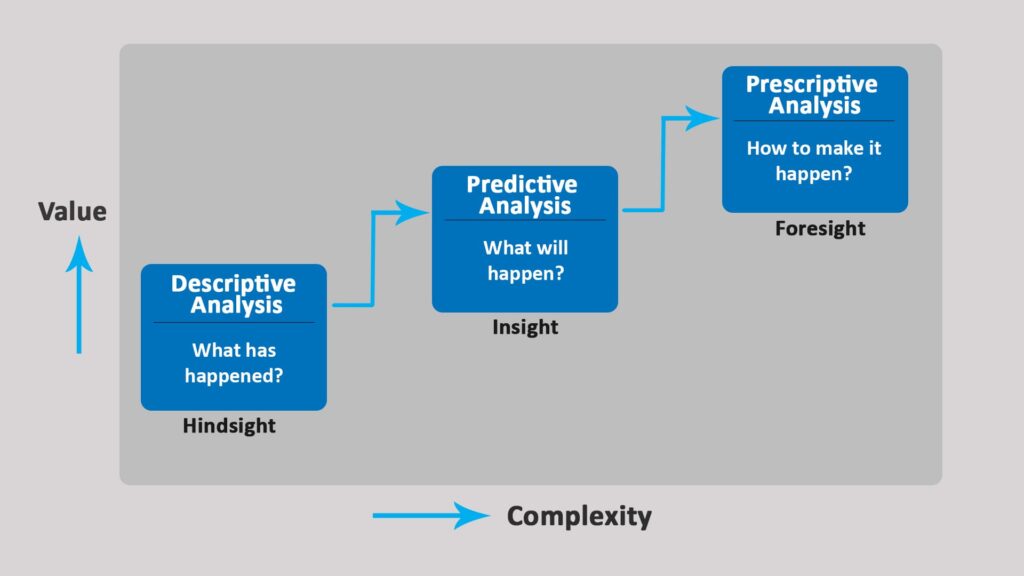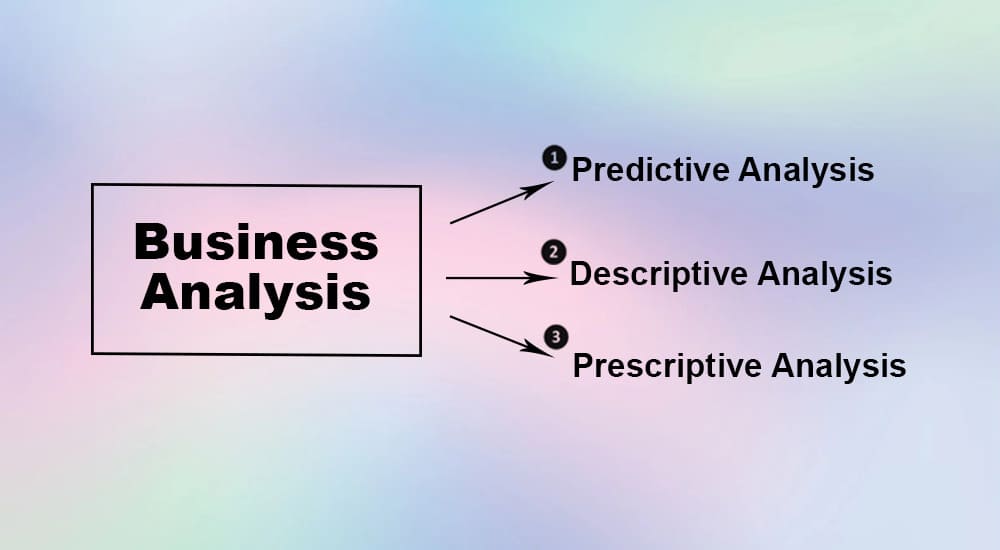In the 1940s, when computers became widely available, governments, businesses, and educational institutions began to emphasize business analysis more. The systems, however, were not effective enough to support massive amounts of data. Later, in the 1990s, more user-friendly software solutions supporting robust business analysis were developed in response to the growing importance of information technology in enterprises.
What is Business Analysis?

Definition: Collecting data about a business, determining what the firm needs, making recommendations for adjustments or solutions, and offering value to the many stakeholders are all aspects of business analysis. Business analysis helps define how firms operate and helps organizations adjust their procedures to increase efficiency.
Types Of Business Analysis

1- Predictive Analysis
The purpose of predictive analysis is to forecast future events by using probability and an enhanced method of analyzing data used in business. Machine learning and statistical modeling are two approaches that can be used to determine, based on historical data, how likely future outcomes are to occur.
Businesses can discover growth possibilities better and find solutions to predicted challenges thanks to predictions of future events.
2- Descriptive Analysis
To uncover shifts and patterns in the business market, the descriptive analysis aggregates and mines past data to conclude the market. It does not offer predictions but rather looks at what has happened in the past better to comprehend the present situation and the current pattern. In this style of business analysis, insights are provided in a format that is simple to comprehend through the use of visual representation.
This is helpful in the day-to-day reporting of a company as well.
3- Prescriptive Analysis
The prescriptive analysis uses the raw results from predictive analysis and provides businesses with the best option. It does this by utilizing various statistical tools to emphasize actionable insights into an event. It does this by collecting information from a variety of descriptive and predictive sources so that it can be used in decision-making.
Decision patterns are then created to help the business assess the results of a decision.
How to Conduct a Business Analysis?
1- Align With The Role
To begin the business analysis, you should familiarize yourself with the position and then move on to understand the project. They need to spend time on the same activities and collect fundamental information contributing to the company’s expansion to understand the project’s scope, history, business objectives, and requirements.
When business analysts try to learn the ins and outs of the current infrastructure and procedures, they more closely align themselves with the project.
2- Identify Business Objectives
Find out what the various stakeholders anticipate from the company so that you can produce results that live up to their expectations. Confusion can be avoided by combining expectations that conflict with one another. A company’s goals ought to be comprehensible, attainable, and defensible.
The project’s scope should be determined by the business objectives, and business analysis should work toward meeting those objectives.
3- Define Business Scope
Defining a clear statement of scope helps identify the business needs. The scope guides the business analysis process. In this step, the technology and process changes are needed to confirm the business case and help business analysis.
4- Create the Business Analysis Plan
The next thing that needs to be done is to create a business analysis strategy that outlines the steps that need to be taken. This plan provides the answers to several questions that have been asked about the company, such as what aspects of the business require immediate attention, the timeline for the analysis, how the analysis will benefit the company, how it will affect the company’s market positioning, and other questions. After gathering all the information necessary to design the solution, the next step is to specify the requirements.
Both the business process and the deliverables can be defined by business analysts, who also can select the business analysis tools that are the best fit. The deliverables cover the scope and identify stakeholder needs and deadlines to complete the analysis.
5- Support The Technicalities
Technicalities in the business analysis process are built, customized, and deployed through software during a project lifecycle. The analysts work with the quality assurance team to understand technical requirements, manage the changes, solve problems through technical support and conduct user testing when needed.
6- Apply the Solutions
After analyzing the data, the following stage is to put that answer into action to accomplish one’s business goals. Business analysts have the responsibility of ensuring that every member of the team is on board with the modifications that have been presented. End users should receive training to ensure they are aware of all procedure changes, and business users should collaborate with end users to test the solutions.
7- Understand the Value of the Solution
The final step in the business analysis process is understanding the value created by the solution. Whether a big problem was solved or small, it is important to study how changes were managed and the role of the solution. Monitor each step in the process and analyze the progress to assess value creation by proposed solutions.
Here is how businesses can do the same:
- Evaluate the progress of the business analysis process
- Convey the results to the manager, team, and others
- Follow the successful solutions and disregard the unsuccessful ones
- Propose follow-up solutions and projects
Top 5 Business Analysis Techniques
1- SWOT Analysis
SWOT analysis is a widely used business analysis technique. It helps businesses identify the corporation’s strengths, weaknesses, opportunities, and threats in the market. Through this, the business can identify the resource allocation needed for business success.
Pros
- It helps in a better in-depth understanding of the business
- Capitalizes on potential opportunities
- Identifies threats before they occur
- Develops business strategies to achieve goals
Cons
- Does not prioritize business issues
- Does not provide specific solutions to deal with the issues
- Guarantees multiple ideas but not a single ideal one
- Produces heavy information but cannot often utilize all of it
2- CATWOE Analysis
CATWOE (customers, actors, transformation process, word view, owner & environmental constraints) technique identifies the key stakeholders and processes affected by business actions. Business analysts can evaluate how actions affect the business elements and define a framework to identify the perspectives, capture information, and use it to manage project changes.
Pros
- Helps in drafting a brief project template
- Systemizes all project needs
- Visualizes the progress of the project
- Helps in managing stakeholders and their expectations
Cons
- It is a lengthy and time-taking process
- Since it is an advanced technique, not all business analysts can use it
- Sometimes, it helps find changes but not solutions.
3- PESTLE Analysis
This technique helps businesses evaluate external political, economic, sociological, technological, legal, and environmental factors that affect the company, the issues involved, and how to address the same. It helps establish the productivity of the business’s present processes and whether or not new product development is required by identifying the direction, growth targets, and brand position of the company.
Pros
- Simplifies the project framework
- Encourages external and internal strategic thinking
- Helps in understanding the wider business environment
- Anticipates future threats and provides a solution
Cons
- At times the data is oversimplified and does not provide reliable results
- This leads to paralysis of analysis when too much data is used
- Missing data is filled based on assumptions
- Analysis conducted can become outdated quickly since everything is dynamic
4- MOST Analysis
The MOST (mission, objectives, strategies & tactics) analysis is used to conduct an internal analysis of the business goals and objectives, how to handle them, and any needed changes. The detailed analysis covers all information about the business’ positioning to identify organizational change, the scope for business growth, policy development, and more. This helps increase business growth and provides stability to the business.
Pros
- Helps in turning business ambitions into realistic objectives
- Helps in building robust and successful businesses
- Clear targets are given to each individual for the success of the business
Cons
- At times the tactics are not aligned with business strategies
- External opinions can sometimes divert the objective achievement
- Management and directors are not always aligned over the business mission in this analysis
5- 5 Whys Analysis
The 5 Whys analysis is a series of five leading questions that start with a ‘why.’ It enables businesses to pinpoint the origin of a problem by gaining knowledge of why a certain circumstance must have arisen, determining the range of potential solutions for the issue, and then selecting and putting into action the most suitable option.
Business analysts ask questions beginning with ‘why’ as many times as needed to get to the root of the problem. The give why questions can be asked like:
- Why did this machinery stop working? (It was overworked)
- Why was the machinery overworked? (There was insufficient machinery to support production)
- Why was there insufficient machinery? (The production level was not anticipated)
- Why was the production not anticipated? (The surge in demand was sudden)
- Why was the demand surge sudden? (A major competitor in the business has stopped its production)
….and so on. The ‘why’ questions are asked until the root cause of the problem is attained, which can either be before the fifth why or after it.
Pros
- It is a powerful tool for non-statistical analysis
- Gets us to the root of the problem
- Helps the team troubleshot, improve quality and solve issues timely
Cons
- Does not allow business analysts to go beyond their existing knowledge
- Results attained cannot be repeated in different situations
- Different analysts can ascertain multiple causes of the problems
Example Of Organizational Business Analysis
Consider a business analyst working with ABC Ltd firm and doing a SWOT analysis to assess the business’ market positioning and trends. He delivers the study in four quadrants: strengths, weaknesses, opportunities, and threats.
After evaluating each quadrant in detail, business analysts determine that the firm’s strength is product differentiation due to inferior alternatives accessible in the market. The weakness is the convoluted pricing policy. As a result, the business analyst proposes ways to launch new items with straightforward pricing policies to capitalize on the strengths.
Moving forward, the business prospects were assessed to determine how they could serve as obstacles for new firms to enter the market. This ensures existing businesses will maintain their maximum market share. Because of this, the company can penetrate other areas while still providing improved services to the customers it already has.
The threat analysis demonstrates that if another business joins the market with a better price, it will be tough for ABC Ltd. to survive in the market for even a year. This is an issue of worry; consequently, the business analyst devises a cost-cutting strategy to further reduce the products’ prices.

Benefits of Business Analysis
- It helps provide businesses with effective and efficient solutions
- Forecasts future events and prepares the businesses for the same
- Identifies organizational requirements and reaches a better understanding of change
- Ensures continued success of a business by prioritizing the business needs
- Reduces company costs through a strong software development framework
- Strengthens a firm’s strategy and decision-making process
- Identifies the market positioning of the business
- Helps in monitoring the progress of a business process or decision
- Updates the business with the dynamic customer-centric requirements and market trends
Summary
An organization must place a major emphasis on business analysis. It assists them in recognizing problems and making the necessary adjustments to combat such problems. This enables firms to achieve maximum efficiency while also delivering value to customers and satisfying their needs. It also assists them in reducing risk, losses, and the possibility of market failure.
